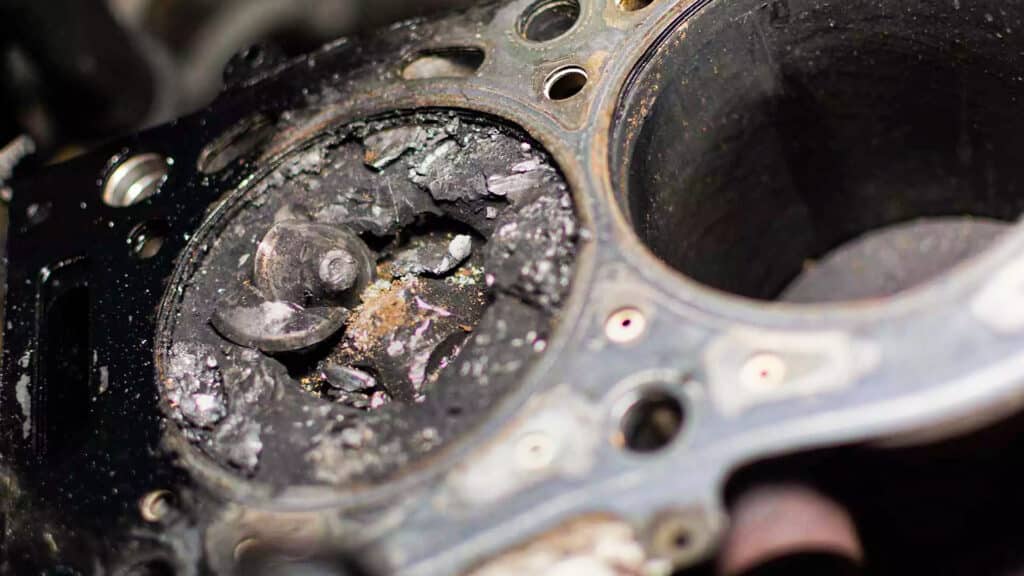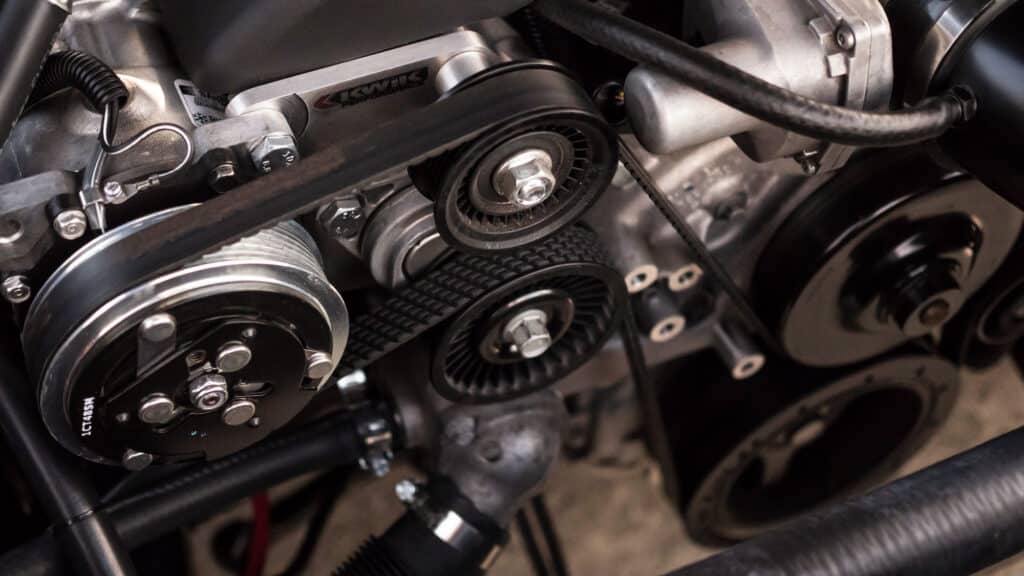Engines are complicated. While the number of cylinders and their configuration may set them apart, the one thing that unites them together is the engineering precision, which is nothing short of magnificent.
Automobile engines are a harmonious display of oddly shaped metals that convert air and fuel into controlled explosions, resulting in the vehicle’s locomotion.
It’s such a delicate process that if one engine component is off by a tenth of a centimeter, you could be looking at a different type of explosion — one that renders you waiting for roadside assistance.
An engine that could potentially leave you stranded (if not properly maintained) is an interference engine.
While all engines require maintenance, these are a bit tricky, and any damage caused can be severe and in many cases irreversible. In this article, we’ll explain the difference between interference vs. non-interference engines.
What Is An Interference Engine?

An engine is categorized as an interference engine based on the piston’s position relative to the valves.
Admittedly, it’s not easy to understand the intricacies of an interference design if you’re not aware of the workings of an engine.
The vast majority of readers might be aware of what pistons, cylinder heads, and camshafts are.
However, those who aren’t mechanically inclined may find these a bit confusing. Terminologies further extend to valves, timing chains, crankshafts, and so on.

A visual representation of how an engine works is a good way to alleviate any kind of confusion surrounding the topic. It’s smooth sailing once you get a hang of the basic operations of an engine.
Pay close attention to the terms pistons, valves, and timing chain/belt because they are the keys to understanding what an interference design is all about.
The valves are responsible for supplying air and fuel, while also being the gateway for exiting the spent gases. When these valves open and close is determined by the timing chain/belt, driven from the crankshaft.

Normally, the valve openings are timed such that the piston and the open valves are never occupying the same space in the cylinder.
Because if they did and assuming the timing’s gone wrong, they’d crash into each other, right? Well, that’s loosely what an interference design is.
Let us be more specific. The highest point the piston can move inside a cylinder is called the Top Dead Center, or TDC.

Let’s say the engine’s timing is off, meaning the valves are not necessarily in a position to close when the piston approaches the TDC (which they should during the compression and power stroke).
When a piston travels far enough towards the TDC and hits the valves, or in other words, occupies the area into which the valves open, the engine is called an interference engine.
What Are Non-Interference Engines?
As you can probably tell, it’s the exact opposite of an interference design.
Engines that don’t have pistons that overlap with open valves, nor extend into an area occupied by a fully open valve, are called non-interference or free-running engines.

You’re probably wondering why Interference engines even exist in the first place. Why not make every engine non-interference?
The answer is not that simple. Everyone wants a powerful yet efficient engine, which in itself is a bit of a contradiction.
It’s not impossible to design an efficient engine that generates decent power, but for that, you need higher compression.
Compression, as you would imagine, is the air and fuel mixture inside the cylinder, squeezed by the piston moving upward. The more you compress the mixture, the more power you make.

Technically, higher compression ratios allow an engine to extract more mechanical energy from the air-fuel mixture thanks to increased thermal efficiency.
However, the piston inside a high-compression engine will have to move a lot closer to the valves, generating more heat to extract the desired output.
Or, in other words, the piston will most certainly be interfering with the valves, a.k.a, an interference engine.
Now that we’ve understood the real reason for having an interference engine, let’s discuss some of its drawbacks.

The most common is internal engine damage caused by the piston hitting the valves when a timing chain/belt fails, which in some cases results in you swapping in a new engine.
In other instances (mostly based on luck), you’ll be looking at “just” damaged pistons and bent valves. Whatever the case, fixing it is a fairly expensive exercise.
List Of Interference and Non-Interference Engines
As an owner of an interference-engined vehicle, your enemy is the timing belt. Make sure you get it changed or adjusted per the manufacturer’s recommended time intervals. You’ll certainly agree if you know what happens when a timing belt breaks.
But wait, how can you tell if an engine is interference or non-interference? Well, if your engine uses diesel fuel, it’s most likely an interference design. If it’s gasoline, then it’s a mix of both.
Fortunately, we’ve listed some popular car engines below based on whether it’s an interference or non-interference design.
However, if your engine is not part of the list, fret not, for a simple Google search with the engine code should give you the answer.
Here’s the list of popular car brands and their respective interference/non-interference engines.
Honda

All Honda engines are interference motors barring the 3.0L and 3.2L J-series engines and a couple of C-series engines. These include:
- J30A1
- J30A3
- J30A4
- J30A5
- J30AC
- J30Y1
- JNA1
- J32A1
- J32A1
- J32A2
- J32A3
- C30A
- C30A
Lexus, Toyota

Non-interference:
- 3E
- 3E-E
- 5E-FE
- 4A-F
- 4A-FE
- 4A-GE (silvertop)
- 4A-GZE
- 7A-FE
- 4A-FE
- 4AF
- 4A
- 4A-LC
- 3.5L V-6
- 3.0L V6
- 2.2L Diesel
- 2.4L Diesel
- 4GR-FSE
- 1MZ-FE
- 1UZ-FE
- 3VZ-E (and all other VZ engines)
- 1JZ
- 7M-GE
- 7M-GTE
- 5M-GE
- 6M-GE
- 2JZ-GE and 2JZ-GTE (interference in VVT-i format, 1998+)

Interference:
- 1998+ 2JZ-GE
- 1.8L Diesel
- 1.8L DOHC Gasoline
- 1A-C
- 3A-C
- 3E
- 3MZ-FE VVT-i
- 1UZ-FE VVTi
- 2UZ-FE
- 3UZ-FE
- 1NZ-FE
- 4A-GE (blacktop)
- 1ZZ-FE
- 2AZ-FE
- 2AR-FE
- 1GR-FE
- 2RZ-FE
- 3RZ-FE
- 2GR-FSE
- 3MZ-FE
- 22-R and 22R-E
- 3UR-FE
- All 1995+ UZ V8 engines regardless of year, vehicle, displacement, or VVT-i
Kia, Hyundai

Non-interference:
- 1.8L DOHC TD8 (Sephia / Spectra)
- 2.0L SOHC FE (Sportage)
- 2.0L DOHC FE (Sportage)
- 1.5L B5-DE
- 1.6L B6
- 1.6L B6D
- 1.5L B5-ME
- 1.5L B5-DE

Interference:
- Alpha/Alpha II
- Gamma/Gamma II
- Theta/Theta II
- Delta/Delta II
Mazda

Non-interference:
- 1.5L
- 1.6L
- 1.8L 4 Cyl.
- 1.8L V6
- 2.0L DOHC (626, MX-6 & Protege)
- 2.0L DOHC (Tribute)
- 2.0L SOHC
- 2.3L 4 Cyl. (B2300)
- 2.3L V6
- 2.5L 4 Cyl. (B2500)
- 2.5L V6
Interference:
- 2.0L Diesel
- 2.2L
- 3.0L DOHC
- 3.0L SOHC
Mitsubishi

Interference:
- 1.5L
- 1.6L DOHC
- 1.6L SOHC
- 1.8L
- 2.0L DOHC 4B11T
- 2.0L SOHC 4G63
- 2.3L Diesel
- 2.4L DOHC
- 2.4L SOHC
- 3.0L DOHC
- 3.0L SOHC 24 Valve
- 3.5L DOHC
- 3.5L SOHC
- 3.8L
Non-interference
- 3.0L SOHC 12-Valve
Nissan

All Nissan engines are Interference engines.
Timing Is Everything

OEMs choose engine designs that best fit the intended application; it could be interference or non-interference. Either way, the engine will only do its job if maintained properly.
While interference engines do get a bit of bad press for their reliability concerns, maintaining them is by no means the end of the world. They’re about as reliable as any non-interference design, subject to the make and model, of course.
The bottom line is that it doesn’t matter what engine design is under the hood. If you stay on top of maintenance, things should be fine. That holds for almost everything mechanical, let alone an engine.
Would you sleep better knowing your car has a non-interference or free-running engine? Let us know by leaving a comment below!
![Interference & Free-Running Engines Explained [Includes List]](https://low-offset.com/wp-content/uploads/2023/12/interference-engine-800x430.jpg)
